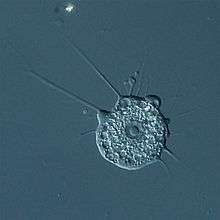Opisthosporidia
Opisthosporidia (granting True Fungi) or Fungi are a sister clade of the Cristidiscoidea together forming the Holomycota. A basal group is the 'basal clone group 2' (BCG2).[2][3] The other basal Opisthosporidan clade are the Aphelida together with the True Fungi, joined with the 'basal clone group 1' (BCG1) together with the Rozellomyceta.[1][4][5][6] Historically, the True Fungi were not considered to have emerged in the Opisthosporidia, i.e. was not considered to be a descendant of the last common ancestor of Aphelida and Cryptomycota.
| Opisthokonts |
| ||||||||||||||||||||||||||||||||||||||||||||||||||||||||||||||||||||||||||||||||||||||||||
| Opisthosporidia | |
|---|---|
 | |
| Sporoblast of Fibrillanosema crangonycis (Microsporidian) | |
| Scientific classification | |
| Domain: | Eukaryota |
| (unranked): | Unikonta |
| (unranked): | Obazoa |
| (unranked): | Opisthokonta |
| (unranked): | Holomycota |
| (unranked): | Zoosporia |
| (unranked): | Opisthosporidia Karpov et al., 2014[1] |
| Groups | |
| |
| Synonyms | |
References
- Karpov, Sergey; Mamkaeva, Maria A.; Aleoshin, Vladimir; Nassonova, Elena; Lilje, Osu; Gleason, Frank H. (2014-01-01). "Morphology, phylogeny, and ecology of the aphelids (Aphelidea, Opisthokonta) and proposal for the new superphylum Opisthosporidia". Frontiers in Microbiology. 5: 112. doi:10.3389/fmicb.2014.00112. PMC 3975115. PMID 24734027.
- Tedersoo, Leho; Sánchez-Ramírez, Santiago; Kõljalg, Urmas; Bahram, Mohammad; Döring, Markus; Schigel, Dmitry; May, Tom; Ryberg, Martin; Abarenkov, Kessy (2018). "High-level classification of the Fungi and a tool for evolutionary ecological analyses". Fungal Diversity. 90 (1): 135–159. doi:10.1007/s13225-018-0401-0. ISSN 1560-2745.
- Torruella, Guifre; Grau-Bove, Xavier; Moreira, David; Karpov, Sergey A.; Burns, John; Sebe-Pedros, Arnau; Volcker, Eckhard; Lopez-Garcia, Purificacion (2018-05-25). "The transcriptome of Paraphelidium tribonemae illuminates the ancestry of Fungi and Opisthosporidia". bioRxiv: 233882. doi:10.1101/233882.
- Silar, Philippe (2016), "Protistes Eucaryotes: Origine, Evolution et Biologie des Microbes Eucaryotes", HAL Archives-ouvertes: 1–462
- Bass, David; Czech, Lucas; Williams, Bryony A. P.; Berney, Cédric; Dunthorn, Micah; Mahé, Frederic; Torruella, Guifré; Stentiford, Grant D.; Williams, Tom A. (2018-04-28). "Clarifying the Relationships between Microsporidia and Cryptomycota". Journal of Eukaryotic Microbiology. 65 (6): 773–782. doi:10.1111/jeu.12519. ISSN 1066-5234. PMC 6282948. PMID 29603494.
- Berbee, Mary L.; James, Timothy Y.; Strullu-Derrien, Christine (2017-09-08). "Early Diverging Fungi: Diversity and Impact at the Dawn of Terrestrial Life". Annual Review of Microbiology. 71 (1): 41–60. doi:10.1146/annurev-micro-030117-020324. ISSN 0066-4227. PMID 28525299.
This article is issued from Wikipedia. The text is licensed under Creative Commons - Attribution - Sharealike. Additional terms may apply for the media files.

